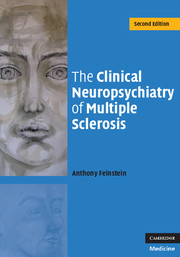Book contents
- Frontmatter
- Contents
- Acknowledgement
- Foreword
- 1 Multiple sclerosis: diagnosis and definitions
- 2 Depression: prevalence, symptoms, diagnosis and clinical correlates
- 3 Depression: etiology and treatment
- 4 Multiple sclerosis, bipolar affective disorder and euphoria
- 5 Multiple sclerosis and pseudobulbar affect
- 6 Multiple sclerosis and psychosis
- 7 Cognitive impairment in multiple sclerosis
- 8 The natural history of cognitive change in multiple sclerosis
- 9 Cognitive impairment in multiple sclerosis: detection, management and significance
- 10 Neuroimaging correlates of cognitive dysfunction
- 11 Multiple sclerosis, disease-modifying treatments and behavioral change
- 12 Multiple sclerosis: a subcortical, white matter dementia?
- Index
- Plate section
- References
1 - Multiple sclerosis: diagnosis and definitions
Published online by Cambridge University Press: 13 August 2009
- Frontmatter
- Contents
- Acknowledgement
- Foreword
- 1 Multiple sclerosis: diagnosis and definitions
- 2 Depression: prevalence, symptoms, diagnosis and clinical correlates
- 3 Depression: etiology and treatment
- 4 Multiple sclerosis, bipolar affective disorder and euphoria
- 5 Multiple sclerosis and pseudobulbar affect
- 6 Multiple sclerosis and psychosis
- 7 Cognitive impairment in multiple sclerosis
- 8 The natural history of cognitive change in multiple sclerosis
- 9 Cognitive impairment in multiple sclerosis: detection, management and significance
- 10 Neuroimaging correlates of cognitive dysfunction
- 11 Multiple sclerosis, disease-modifying treatments and behavioral change
- 12 Multiple sclerosis: a subcortical, white matter dementia?
- Index
- Plate section
- References
Summary
Many a chapter, monograph and paper on multiple sclerosis (MS) begins with the observation that the disease is the most common cause of neurological disability in young and middle-aged adults. While the emphasis for much of the nineteenth and twentieth centuries was on the neurological manifestations of the disease, since the mid 1980s clinicians, researchers and patients have become more aware of the associated behavioral changes. A burgeoning literature devoted to the neuropsychiatry of MS attests to this new found interest, although those with knowledge of the medical history of MS may find themselves a little surprised why it took so long for this enthusiasm to re-ignite. Descriptions of altered mentation in MS patients long predate the man credited with naming, describing and making the condition known, the French behavioral neurologist Jean-Martin Charcot (Charcot, 1868; see also Murray, 2005).
One cannot describe the psychiatric and cognitive changes associated with MS without first referring to the neurology and pathology of the disorder. This chapter, therefore, begins with a summary of the pathogenesis, pathology, signs and symptoms, diagnosis and differential diagnosis of MS. With the book's emphasis on mentation, this introduction will by design be brief and those seeking more detailed explanations are encouraged to consult the many texts specifically devoted to these aspects. This chapter will, however, discuss in depth the research guidelines for diagnosing MS and furnish clear definitions for terms that apply directly to the disease.
- Type
- Chapter
- Information
- The Clinical Neuropsychiatry of Multiple Sclerosis , pp. 1 - 27Publisher: Cambridge University PressPrint publication year: 2007



